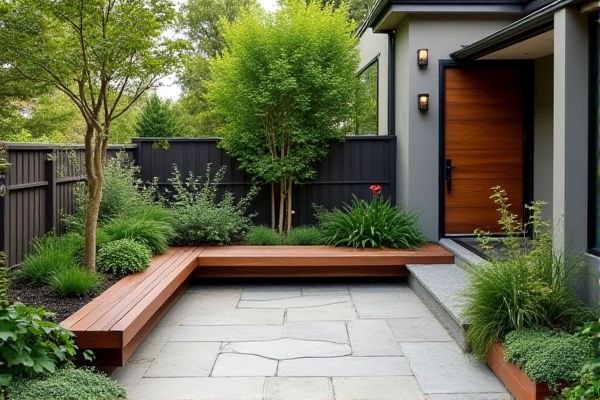
A built-in planter bench seamlessly integrates greenery and seating, saving space while creating a cohesive design in your outdoor area. Discover the pros and cons of each option to decide which best suits your style and functional needs by reading the rest of the article.
Table of Comparison
| Feature | Built-in Planter Bench | Separate Planters |
|---|---|---|
| Integration | Seamlessly integrated into seating design | Standalone units, flexible placement |
| Space Efficiency | Maximizes use of limited space | Requires additional floor space |
| Mobility | Fixed location, non-movable | Easy to move and rearrange |
| Design Flexibility | Limited customization, pre-designed | Highly customizable in style and size |
| Maintenance | Integrated drainage may be complex | Simple drainage and easy cleaning |
| Cost | Higher upfront cost, built-in construction | Generally lower cost, purchasable separately |
Introduction to Built-in Planter Benches and Separate Planters
Built-in planter benches combine seating and greenery into a single integrated structure, maximizing space efficiency and creating a cohesive outdoor design. Separate planters offer flexibility in placement and style, allowing you to easily rearrange or change your garden layout without altering fixed furniture. Choosing between built-in benches and separate planters depends on your space constraints, maintenance preferences, and desired aesthetic impact.
Space Efficiency: Maximizing Your Outdoor Area
Built-in planter benches optimize space by combining seating and greenery into a single functional unit, ideal for small patios and balconies. Separate planters require additional floor area, which can limit usable space and create a cluttered appearance. Maximizing your outdoor area is easier with built-in designs that integrate plants seamlessly, enhancing both aesthetics and functionality.
Design Flexibility and Aesthetic Appeal
Built-in planter benches offer integrated design flexibility by combining seating and greenery into a seamless structure, enhancing your outdoor space with a cohesive aesthetic appeal. Separate planters provide greater versatility, allowing you to rearrange or swap plants seasonally to refresh your design without altering the furniture. Choosing between these options depends on whether you prioritize a fixed, unified look or adaptable, personalized planting arrangements.
Installation Complexity and Requirements
Built-in planter benches require advanced installation involving structural modifications, secure anchoring, and possible plumbing or irrigation system integration, making the process more complex and time-consuming. Separate planters offer flexibility with minimal installation, allowing easy relocation or seasonal changes without altering your outdoor space's structure. Your choice impacts both the durability and maintenance demands based on installation requirements.
Material and Durability Comparison
Built-in planter benches are typically constructed from durable materials such as treated wood, composite, or concrete, designed to withstand weather exposure and provide long-lasting structural support. Separate planters offer versatility with materials ranging from lightweight plastic to ceramic and metal, each varying in durability and resistance to elements. You should consider that built-in options generally ensure greater stability and endurance, while separate planters allow easier replacement and customization.
Maintenance and Upkeep Differences
Built-in planter benches require integrated maintenance, involving checking for structural integrity, waterproofing, and soil health to prevent damage to the bench itself. Separate planters offer more flexibility, allowing for easier removal, individual cleaning, and targeted plant care without affecting surrounding furniture. Both require regular watering and pruning, but built-in designs may demand more frequent inspections to avoid issues like water damage or soil spillage.
Comfort and Functionality Considerations
Built-in planter benches offer enhanced comfort through integrated seating designed specifically for outdoor spaces, combining functionality by saving space and providing a cohesive aesthetic. Separate planters provide flexibility in placement and mobility, allowing easy rearrangement to suit changing seating needs or seasonal plant rotations. The choice depends on balancing permanent, ergonomic seating comfort with the adaptable functionality of movable planting options.
Cost Analysis: Budgeting for Your Project
A built-in planter bench typically involves higher initial costs due to custom construction and materials, but it offers long-term value through durability and integrated design. Separate planters provide flexibility and lower upfront investment, allowing you to update or move plants without significant remodeling. When budgeting your project, consider your landscape layout, maintenance preferences, and whether your priority is a seamless aesthetic or cost-effective versatility.
Plant Selection Suitability
Built-in planter benches offer a controlled environment ideal for deep-rooted or large plants, providing stability and integrated irrigation options that enhance growth. Separate planters allow more flexibility in plant selection, accommodating a diverse range of species with varying soil and drainage needs. Choosing between the two depends on the specific plant requirements and the desired landscaping design.
Best Uses and Ideal Settings
Built-in planter benches are best suited for urban patios, small gardens, or contemporary outdoor spaces where maximizing seating and greenery simultaneously is key, offering seamless integration and space-saving benefits. Separate planters provide flexibility and versatility, ideal for large gardens or varied landscapes where plants may need to be moved, rearranged, or changed seasonally to suit evolving design or environmental needs. Your choice depends on whether you prioritize permanence and cohesion with built-in options or adaptability with standalone planters for dynamic garden settings.
 homyna.com
homyna.com